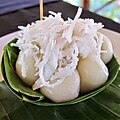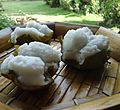Rice cake
Rice cakes are a type of food made from rice that has been shaped and compressed into a single object. They are a versatile food item found in many different cultures around the world, with each culture having its own unique version of a rice cake. Rice cakes can be sweet or savory, and they can be eaten as a snack, dessert, or even as a staple part of a meal.
History[edit]
The history of rice cakes dates back thousands of years, with their origins deeply rooted in Asian cultures. In countries like Japan, Korea, and China, rice cakes have been a significant part of traditional festivities and daily meals. Over time, the popularity of rice cakes spread to other parts of the world, adapting to local tastes and ingredients.
Types[edit]
There are many different types of rice cakes, each with its own preparation method and flavor profile. Some of the most popular include:
- Mochi - A Japanese rice cake made from glutinous rice pounded into paste and molded into shape.
- Tteok - A Korean rice cake that comes in many varieties, often steamed, pounded, or boiled.
- Puto - A Filipino steamed rice cake, traditionally made from slightly fermented rice dough.
- Idli - A type of savory rice cake popular in South India, made by steaming a batter consisting of fermented black lentils and rice.
Preparation[edit]
The preparation of rice cakes varies significantly depending on the type. Generally, it involves cooking rice or a rice-based batter and then shaping it into cakes. Some rice cakes are made from whole rice grains, while others use ground rice or rice flour. The rice or batter can be steamed, boiled, fried, or baked to create different textures and flavors.
Cultural Significance[edit]
Rice cakes hold cultural significance in many countries. For example, in Korea, tteokguk (a soup with sliced rice cakes) is traditionally eaten during the celebration of the Lunar New Year to symbolize gaining a year of age and the hope for a prosperous year. In Japan, mochi is often made and eaten during New Year's celebrations as a symbol of longevity and well-being.
Nutritional Value[edit]
Rice cakes are generally low in calories and fat, making them a popular choice for people looking for a light snack. However, since they are primarily made of rice, they are high in carbohydrates. The nutritional value can vary greatly depending on the type of rice cake and its additional ingredients.
See Also[edit]
Rice_cake[edit]
-
Pink seolgitteok cake
-
Quaker Popped Rice Snacks
-
Num Plae Ai
-
Ciba cake
-
Sweet Tea Olive Cake
-
Pumpkin tangyuan with red bean baste and black sesame fillings
-
Kakaning Pinoy (The Filipino Rice Cakes)
-
Puto in banana leaf
Ad. Transform your life with W8MD's Budget GLP-1 injections from $75


W8MD offers a medical weight loss program to lose weight in Philadelphia. Our physician-supervised medical weight loss provides:
- Weight loss injections in NYC (generic and brand names):
- Zepbound / Mounjaro, Wegovy / Ozempic, Saxenda
- Most insurances accepted or discounted self-pay rates. We will obtain insurance prior authorizations if needed.
- Generic GLP1 weight loss injections from $75 for the starting dose.
- Also offer prescription weight loss medications including Phentermine, Qsymia, Diethylpropion, Contrave etc.
NYC weight loss doctor appointmentsNYC weight loss doctor appointments
Start your NYC weight loss journey today at our NYC medical weight loss and Philadelphia medical weight loss clinics.
- Call 718-946-5500 to lose weight in NYC or for medical weight loss in Philadelphia 215-676-2334.
- Tags:NYC medical weight loss, Philadelphia lose weight Zepbound NYC, Budget GLP1 weight loss injections, Wegovy Philadelphia, Wegovy NYC, Philadelphia medical weight loss, Brookly weight loss and Wegovy NYC
|
WikiMD's Wellness Encyclopedia |
| Let Food Be Thy Medicine Medicine Thy Food - Hippocrates |
Medical Disclaimer: WikiMD is not a substitute for professional medical advice. The information on WikiMD is provided as an information resource only, may be incorrect, outdated or misleading, and is not to be used or relied on for any diagnostic or treatment purposes. Please consult your health care provider before making any healthcare decisions or for guidance about a specific medical condition. WikiMD expressly disclaims responsibility, and shall have no liability, for any damages, loss, injury, or liability whatsoever suffered as a result of your reliance on the information contained in this site. By visiting this site you agree to the foregoing terms and conditions, which may from time to time be changed or supplemented by WikiMD. If you do not agree to the foregoing terms and conditions, you should not enter or use this site. See full disclaimer.
Credits:Most images are courtesy of Wikimedia commons, and templates, categories Wikipedia, licensed under CC BY SA or similar.
Translate this page: - East Asian
中文,
日本,
한국어,
South Asian
हिन्दी,
தமிழ்,
తెలుగు,
Urdu,
ಕನ್ನಡ,
Southeast Asian
Indonesian,
Vietnamese,
Thai,
မြန်မာဘာသာ,
বাংলা
European
español,
Deutsch,
français,
Greek,
português do Brasil,
polski,
română,
русский,
Nederlands,
norsk,
svenska,
suomi,
Italian
Middle Eastern & African
عربى,
Turkish,
Persian,
Hebrew,
Afrikaans,
isiZulu,
Kiswahili,
Other
Bulgarian,
Hungarian,
Czech,
Swedish,
മലയാളം,
मराठी,
ਪੰਜਾਬੀ,
ગુજરાતી,
Portuguese,
Ukrainian









